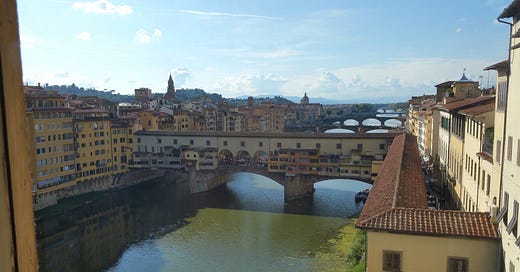Even from the very beginning, Rome has always had a strong connection with rivers.
Romulus and his twin brother Remus had just been abandoned by the side of the Tiber river. As luck had it, a female wolf happened to be wandering by. Naturally, as one does, she raised the human babies as her own, nursing them on the milk of wolves.
The Tiber flowed right through ancient Rome, and it still flows through present-day Rome today. Florence, too, has a river that’s central to the town called the Arno, but it’s the bridge that makes this spot famous. It’s the Ponte Vecchio, a famous medieval bridge that Alley and I got to see in 2017:
Crossing to the other side of the river in the ancient Roman world was a very big deal. The Latin word for river derived from an older word rivus, which ultimately became rivere in Old French, and English eventually dropped the -e at the end.
Rivus also branched off into a stream of its own—literally, I mean. Rivus came to mean a stream of water that had branched off of a river, and a person who used that stream was called a rivalis (singular). Rival and river, then, share a common origin, and the meaning of rival derives from a person who is competing over a shared resource.
Romulus and Remus were rivals in the sense that they came from the same river, but they became rivals in a different sense, leading to the infamous fratricide at the heart of Rome’s foundational myth.
Crossing to the other side was incredibly significant, like when Julius Caesar walked across that one river - no big deal, right?
He crossed the Rubicon, and everything changed. Hundreds of years of tradition crumbled in an instant, although Rome continued its polite fiction once the dust settled by pretending its empire was still a republic.
It’s fitting that walking across a body of water was the symbolic end to the republic. For the ancient world, crossing over to the other side was a bold action. Today, we might think nothing of a drive over a toll bridge, but crossing a river in the ancient world was almost always fraught with danger.
Rivals in the ancient world specifically describes a type of person who fought for shared resources—namely, water. Today’s rivals might fight over the privilege to be considered the best, like when the Yankees and the Red Sox face off or when an individual rivalry forms between number one and number two.
In the Colosseum (the lame/boring hull you see in the image above), rivals would sometimes fight to the death. Today’s sports rivals are just trying to score points most of the time, although I’ve seen some modern rivalries get pretty heated.
You can find traces of Latin everywhere in modern English, and in many parts of the world, they’re still speaking a derivative of Latin that might be called Portuguese or French or Italian nowadays—but make no mistake about it, they still speak Latin today.







Haha did Alley approve that picture, Andrew? 🤣
I hiked to the headwaters of a river once. Didn’t plan on it, but the trail looked nice, alongside a tumbling creek and past a waterfall. At the top—no river! We ended up in a meadow around 8000 feet up, like an inverse sponge with water coming up from the ground, collecting in marshy pools that wound through the meadow, creating the river.